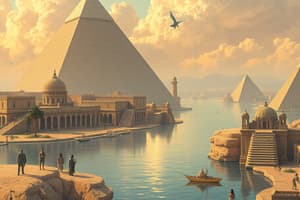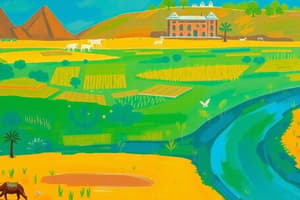Podcast
Questions and Answers
What was the primary function of the Nile River for the ancient Egyptians?
What was the primary function of the Nile River for the ancient Egyptians?
- Serving as the main route for military campaigns.
- Providing a source of precious stones and metals.
- Supplying water for irrigation and transportation. (correct)
- Offering a natural defense against invaders.
What was the significance of the annual Nile flood for Egyptian agriculture?
What was the significance of the annual Nile flood for Egyptian agriculture?
- It diluted the soil with excessive salts.
- It destroyed crops, forcing Egyptians to import food.
- It carried away important irrigation infrastructure.
- It deposited fertile mud, making the land ideal for farming. (correct)
What engineering achievements did the Egyptians use to maximize the Nile's water?
What engineering achievements did the Egyptians use to maximize the Nile's water?
- They constructed dams and canals. (correct)
- They built aqueducts and watermills.
- They developed underground springs and wells.
- They used sophisticated water pumps and filters.
What does the map provided depict about Ancient Egypt?
What does the map provided depict about Ancient Egypt?
What was the geographic characteristic of the land along the Nile River?
What was the geographic characteristic of the land along the Nile River?
What was the purpose of the questions provided alongside the map of Ancient Egypt?
What was the purpose of the questions provided alongside the map of Ancient Egypt?
What does the map use to represent different aspects of Ancient Egypt?
What does the map use to represent different aspects of Ancient Egypt?
Based on the context, what was significant about the water source mentioned in the ‘Tomb of Irynefer’?
Based on the context, what was significant about the water source mentioned in the ‘Tomb of Irynefer’?
Flashcards
What is the significance of the Nile River in Ancient Egypt?
What is the significance of the Nile River in Ancient Egypt?
The Nile River flows southward through the desert, creating a fertile strip of land. It's essential for water, agriculture, and transportation in Ancient Egypt.
What is the importance of the Nile's annual flood?
What is the importance of the Nile's annual flood?
The annual flooding of the Nile River brought rich, fertile mud to the land, making it ideal for agriculture. This cycle was crucial for the development of Egyptian civilization.
How did the Egyptians manage the Nile's water?
How did the Egyptians manage the Nile's water?
The Egyptians built dams and canals to control and distribute the Nile's water, ensuring efficient use for agriculture and other purposes.
What are the two main regions of Ancient Egypt?
What are the two main regions of Ancient Egypt?
Signup and view all the flashcards
What are the major kingdoms of Ancient Egypt depicted on the map?
What are the major kingdoms of Ancient Egypt depicted on the map?
Signup and view all the flashcards
What do the different symbols on the map represent?
What do the different symbols on the map represent?
Signup and view all the flashcards
What modern countries encompass the largest extent of Ancient Egypt?
What modern countries encompass the largest extent of Ancient Egypt?
Signup and view all the flashcards
What are some major cities of Ancient Egypt shown on the map?
What are some major cities of Ancient Egypt shown on the map?
Signup and view all the flashcards
Study Notes
Ancient Egypt: A Gift from the Nile
- Egyptian civilization emerged over 5000 years ago in Africa, along the Nile River.
- The Nile River flows from south to north, creating a fertile strip of land in the desert.
- The annual flooding of the Nile deposited fertile black soil called 'black land', crucial for agriculture.
- The 'red land' refers to the desert regions surrounding the fertile valley.
- Egyptians used canals and dams to manage the Nile's water for agriculture.
- The Nile was the primary source of water, transportation, and trade.
- Main towns and buildings were located near the Nile because of its resources.
- Key cities in Upper and Lower Egypt included Memphis, Thebes, Giza, Saqqara, Heliopolis, and others.
Ancient Egyptian Civilization Boundaries
- Ancient Egypt's boundaries were primarily defined by the Nile River valley and its surrounding deserts.
- The civilization encompassed parts of North Africa.
Ancient Egyptian Capitals
- The capitals of Egypt shifted over time, but major cities and locations functioned as capitals.
- These locations are marked for reference, and include Memphis, Thebes, Giza etc.
Ancient Egypt's Size and Political Influence
- Ancient Egypt expanded to its greatest size at different periods in its history.
- The political map of the time period shows political control areas.
Studying That Suits You
Use AI to generate personalized quizzes and flashcards to suit your learning preferences.




